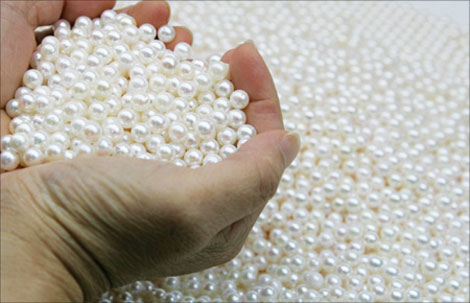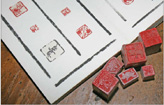Pearls of wisdom
Updated: 2011-05-27 11:01
By Lin Jing (China Daily European Weekly)
 |
|
Chinese cultured pearls make up 95 percent of the world market, but the quality is low. Domestic pearl producers are now looking at ways to raise the standard. Provided to China Daily |
Chinese pearl farmers dominate the world market but now want to work smarter, not harder
The Chinese pearling industry has a 4,000-year history and in ancient times, the precious gem symbolized fortune and authority. Emperors used pearls in their imperial gowns and crowns to show their power and dignity. About 1,000 years ago, China became first country to farm cultured pearls and today the nation is still the largest cultured pearl producer and exporter in the world with 95 percent market share. But despite overwhelming market domination, revenue is surprisingly small because of the low-quality pearls it produces. Now the industry wants to raise the bar, and is investigating ways to create better, more in-demand products.
"China produced more than 1,400 tons of cultured pearls in 2009, and ranks first in the world in terms of production volumes, taking up 95 percent of the world total. However, the value is less than 10 percent of it all," says Shi Hongyue, deputy secretary-general of Gems & Jewelry Trade Association of China.
Shi says about 70 percent of the production volume is exported to other countries annually as raw materials for further processing, and the enormous potential of the domestic market has not been fully developed.
"Compared to other expensive jewelry made of gold and silver, pearls take up a very small portion of domestic jewelry market," says Shi.
"In 2010, the sales of all jewelries reached 25.8 billion euros, but pearls only took up less than 1 percent. There is still a huge room for increment."
The modern pearl cultivation method, which has been mastered by the Chinese, was first developed by a British biologist named William Saville-Kent in 1905 and it was adapted and improved by the Japanese in the 1920s. Since the 1950s, cultured pearls have made up the majority of pearls in the market place.
Compared with natural pearls found in the ocean, freshwater cultured pearls mature much faster but because of their quality and high volume are significantly cheaper.
The value of pearls is determined by luster, color, size and quality of surface. Among these attributes, luster is the most important indicator of quality and large and perfectly round pearls are highly valued.
Shi says the large amount of middle and low-end pearls from China flooding the world market has lowered the nation's pearl quality reputation.
"Many new enterprises in China have began to produce cultured pearls and push up the production volume," Shi says.
"The direct result is that many enterprises become eager for instant financial benefits and neglect the quality. Most of their products are middle and low-end quality pearls, which have very low prices in the market."
Shi says that although high-quality pearls represent only 5 percent of the total world volume, their prices can range from 50 to 500 euros each, compared to low-end pearls, which may only cost about 5.5 euros.
Now some forward-looking enterprises have increased their research and development (R&D) investment and technology support to shift their focus from mass production to diversified pearl products with higher value.
"To develop high value added products, every year we invest more than 5 percent of revenue into R&D," says Zhou Shuli, chairman of gN Pearl, a pearl company in southern China's Hainan province.
Since its establishment in 1992, the company has successfully secured 43 patents in pearl processing technology and products.
Zhou says the company's annual revenue is about 32.2 million euros and is rapidly expanding with an average annual growth rate of 50 percent. The gN brand has about 350 direct-sale stores and 670 franchised chain stores across China.
Last year, gN invested 10.7 million euros to build China's largest pearl processing base and the complex in Hainan, and the plant will start operation in September.
"With this base, we plan to apply more existing technology on pearl processing and develop new healthcare products and cosmetics containing pearls," Zhou says.
Researchers claim that various components of pearl can stimulate the metabolic activities of the genetic material in a cell - the DNA and RNA - and thus can promote and accelerate cell renewal.
In addition to R&D investment, the company has also built the first pearl museum in Hainan, in an effort to better promote pearl culture.
"The promotion of pearl products should be combined with inherence and innovation of pearl culture," says Zhou.
"Nowadays pearls are no longer the symbol of power and dignity as the old times, but a declaration of matureness, elegancy and decency."
Although pearl jewelry represents only a small percentage of the world market, Zhou is still confident in its future.
"Pearls have a deep-rooted cultural background in China," he says. "With proper promotion, people will gradually begin to appreciate the inner value and culture of pearl jewelry."
The most valuable pearls are not farmed and grow in the wild. They are extremely rare and sell at a very high prices as collector's items.
In 2005, La Regente, the fifth largest natural pearl in the world, was auctioned for 1.8 million euros. It is called the Napoleon pearl because it was the centerpiece of a pearl tiara, which Napoleon Bonaparte gave to his wife.
There are some memorable stories about how pearls have been used by the world's rich and famous. In 1917, jeweler Pierre Cartier purchased the Fifth Avenue mansion, which is the now New York Cartier store, with a double strand of natural pearls that he had been collecting for years.
Chinese industry experts suggest that pearl products should quicken its transition into luxury industry that could bring a higher value.
Ren Jin, vice department head of Gemmological Institute with China University of Geosciences, says that current pearl jewelry tended to have similar designs and forms and suggests that pearl enterprises should apply more advanced design to increase products value and gradually evolves from the raw materials to luxury goods.
"In order to get rid of the current predicament of mass production of cheap products and seek further development, Chinese pearl companies must come up with more innovative, competitive and high quality products," he says.
E-paper

Pearl on the Yangtze
Wuxi is considered a town of natural beauty and its motto is "city of water and warmth".
Prose and consternation
Riding on a mystery train
Way of a warrior
Specials

Wealth of difference
Rich coastal areas offer contrasting ways of dealing with country's development

Seal of approval
The dying tradition of seal engraving has now become a UNIVERSITY major

Making perfect horse sense
Riding horses to work may be the clean, green answer to frustrated car owners in traffic-trapped cities
